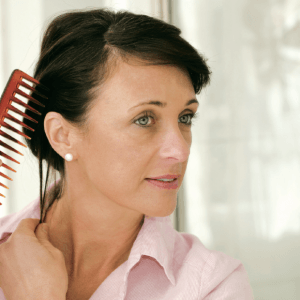After 20 Years of Thinning Hair, One Woman Found Help in Wellesley

Photo credit: Shutterstock
Terri was only in her early 30s when she first observed her hair loss.
“I first noticed a thinning on the top of my scalp,” says the Attleboro resident. “My hairbrush seemed to be increasingly full of hair after styling, as was the bathroom drain.”
In the 1990s, Terri’s options were limited. “There really wasn’t any treatment out there exclusively for women, let alone the ability to do internet research regarding the problem,” she says.
Terri immediately sought a medical evaluation due to a history of hypothyroid in her family, but the tests returned normal. At the time, doctors didn’t consider administering a hormone panel to determine estrogen, progesterone, and testosterone levels. With no other options, Terri began taking high doses of multivitamins identified for hair growth and a physician eventually prescribed aldosterone to inhibit testosterone—but nothing worked.
“We’ve all seen middle-aged women with hair loss so extensive you can see the person’s scalp,” Terri says. “I was concerned and stressed out that I was headed in that direction. I was self-conscious at work, and especially about dating. Hair loss in women is far more emotional than it is for men because there is a societal acceptance that a bald-headed man can still be attractive; that’s not often the case with women.”
Over the years, Terri turned to the internet, periodically Google searching for hair loss treatments for women. “You can find centers for ‘enhancements,’ and multiple products making claims that they can give you thicker, stronger hair,” she says. “But that’s not what I wanted—I was looking for a solution.”
Finally, she found Medi Tresse.




Starting with a consultation appointment, a comprehensive review of her medical history, and scalp evaluation, Terri discussed a variety of available options with Dr. Mary Wendel’s staff. “I had explored their website and I was particularly interested in PRP therapy or the laser cap,” she says.
Platelet Rich Plasma (PRP) therapy has been used to improve hair health and help regrow hair for patients suffering from Androgenic Alopecia (Female Pattern Hair Loss), Alopecia Areata, and Traction Alopecia. The therapy isolates the platelet rich portion of your blood to concentrate natural growth factors and stem cells to up to 10 times greater than normal. PRP stimulates new hair growth by reactivating dormant follicles and healing the follicle at a cellular level for healthier, thicker hair.
“My treatment plan included three PRP sessions, one month apart,” says Terri. “I had the option to add stem cells to one of those treatments, and I figured at 57 years old when I’ve been post-menopausal for a decade, I was ready to do it all.”
Terri was also instructed to use a topical solution called Formula 82M, compounded at a pharmacy and available through Medi Tresse. The solution contains minoxidil, retinol, and other ingredients that were gentle on the scalp and still allowed for daily styling. “This was critical for me as other over-the-counter minoxidil products I’ve tried proved oily and miserable to apply,” says Terri.
In addition, Terri purchased the LaserCap, a method of Low-Level Laser Therapy (LLLT) at Medi Tresse. “It looks like a baseball cap and you wear it for 30 minutes every other day,” she says. “It’s super easy and convenient. I use it at night while I watch the evening news.”
About 12 weeks into treatment, Terri had a follow-up appointment, where the nurse practitioner was pleasantly surprised by the early results. “I was already showing hair regrowth, particularly around my hairline and sides,” Terri says. “This was so encouraging and like anything else, when you see results, it fuels your compliance. I definitely see and feel a difference, and I’m super happy I made the investment.”
Terri says there were two people who especially noticed her new hair growth; the first was her hairdresser. “My hairstylist sees me monthly for color and she’s been with me on this journey since the beginning, which has been about 17 years,” she says. “She noticed early on that I had new growth coming and would comment every time she saw me that my scalp felt ‘padded’ because the new growth was giving me lift. She actually told other clients my story and showed them my before and after photos.”
The second person was Terri’s husband. “He noticed a difference at the one-year mark and commented on it. Until that moment, we had never discussed what he knew had to be a sensitive topic for me,” she says. “But he’s 6’4”. He told me, ‘Of course I could see it. I’m a full foot taller than you.’”
Terri encourages women suffering in silence to seek help from Medi Tresse as soon as possible.
“Don’t wait,” she advises. “It’s not going to get better or go away. There’s never been a time in the last 20 years when I’ve had this much hope. I’m so grateful that I found a medical center focused on treatment for women by women.”
For more information on female hair loss and nonsurgical treatment options, visit meditresse.com.
This is a paid partnership between Medi Tresse and Boston Magazine


